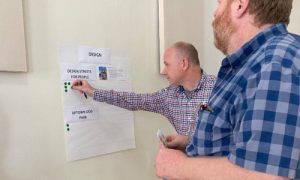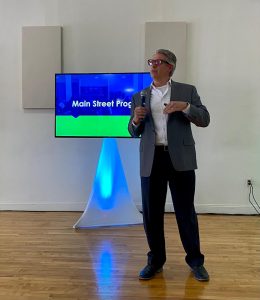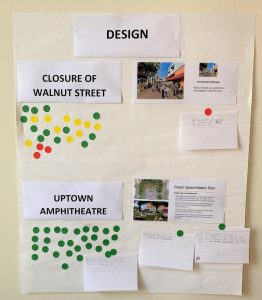“Why is uptown important?” Jeff Sadler asked a crowd of around 75 people gathered in the TAD Space in uptown Martinsville. They came together for the second in a series of four community engagement conversations about uptown’s current revitalization effort, spearheaded by Uptown Partnership (UP) and its executive director, Kathy Deacon.

While attendees had the opportunity to provide input on prioritizing some potential revitalization projects at the end of the session, much of the second meeting was dedicated to Sadler, who described the Main Street approach and methodology for revitalizing downtowns (or, in Martinsville’s case, uptown.)
As Deacon explained, Martinsville is currently a Main Street Affiliate but is working toward the next tier Main Street designation. Before Sadler described the central tenants and functions of the Main Street program, he first broached the big question—why is uptown important at all?
“I think most people get this now,” he said, but a decade or so ago, that was not the case. Uptown, he explained, is a prominent center of employment and a significant part of the city’s tax base. “It’s the most densely-built part of the city. It’s also usually the most privately-owned properties.” Additionally, uptown is the ideal location for independent businesses, he said. “It was built for independent businesses, the scale of the buildings was made for independent businesses.”
Uptown also is the historic core of the community. “This is where decisions were made, good and bad,” he said, adding that investments were made in uptown and it was historically the place for social activities.
Further, he said, uptown is the predominant image of the community. “Nobody comes into the community and says, ‘man, Martinsville has the best Walmart I’ve ever been to.’ It might be the best Walmart, but nobody really thinks about that. They think about what are the unique attributes of the community and the historic business district is really where it’s all centered.”
And finally, uptown “represents a huge public and private investment,” he said. “All the sidewalks, all the water and sewer, all the streets, all the alleyways,” electric, gas lines, buildings and their upgrades, repairs, and updates, all are representations of that investment.
Revitalization barriers

Sadler gave a number of reasons that every downtown/uptown area does not get revitalized. First, it is a long-term process and takes a deal of hard work. “You’ve got to continue to do it,” he said, often with volunteers rotating in and out of the process to avoid burnout.
Secondly, he said, previous attempts at revitalization may have failed, possibly due to wrong ideas or poor implementation. He also cited an apathetic public as another reason for lack of a revitalization effort.
Another barrier to revitalization, Sadler said, is competing interests. “Property owners don’t always agree on what should go on. Local governments don’t always agree on who should be in charge,” he said, adding that “I’m not saying those disagreements are going on specifically here.”
Old ideas and perceptions also could hinder a revitalization effort. Oftentimes, Sadler explained, “people aren’t following the trends of what’s going on and so they are trying to do what would have been a great idea in 1999 but it’s 2022.”
“The good news is that that Main Street Approach works despite these challenges,” Sadler said. “I have never seen a case where someone actually diligently follows the process where it has not been successful. It may not be as successful as they want it to be, but it has always been successful. Where I have seen it not be successful is when people say ‘we are Main Street’ but they don’t actually do Main Street.”
Main Street methodology

Sadler explained that the Main Street program is a methodology combining historic preservation, economic development, and public involvement for prosperity and vitality uptown. It was founded by the National Trust for Historic Preservation around the time that bypasses and shopping malls were being built, causing downtowns to suffer. He said that the trust did some pilot programs in the 1970s to learn which methods worked and which did not, and that the organization constantly refines and updates its methodology.
“The reason historic preservation is important,” Sadler explained, “is because it really helps you show off the identity of the community and create a sense of place … You want to create a place where people feel comfortable, safe, interested, and that they have opportunity … People have choices in where they want to come and where they want to live and where they want to be. It’s not like before where you travel for jobs. Now jobs travel for workers so getting people interested is the basis of it all.”
He said that, traditionally, Martinsville has not done a good job with historic preservation uptown. “You guys really have some amazing architecture here and I encourage you to treasure it because you can’t recreate it,” he said.
The Main Street approach, he explained, uses the traditional assets of an area—the built environment, the people, and the history—as a catalyst and basis for revitalization. Outcomes of that revitalization are increased entrepreneurship, pride, strong public/private partnerships, vibrancy, equity both in terms of equality and ownership, and sense of place.
Place, he said, is “what you’ll hear over and over again through Main Street, creating that sense of place, that special place.”
Sadler went on to describe the organization of a Main Street program, noting that it was required at the state and national level to be separate and independent because of the need to make decisions about uptown by those who comprise the uptown community—those who use uptown, uptown property owners, and those that work or own businesses in the area.
It must be a formally organized group, he said, rather than an ad hoc group of people, and made up of stakeholders with a full board of directors and committee structure.
Further, he said, a Main Street organization must be volunteer-driven and staff coordinated. “This part’s really important,” he said.
Sadler told the crowd that he has been coming to Martinsville for nearly 15 years, trying to work with the uptown district. “One things I’ve heard pretty consistently throughout that is that somebody in these meetings will say, ‘well, who’s going to do this?’ And the answer is it’s you. Kathy (Deacon) is the staff. Her job is to coordinate all your efforts so you’re not bumping into each other, to make sure the resources are available and they’re at the right place at the right time and all the planning is done. But really, the work has to be you and everybody you know.”
The work of a Main Street organization is centered around 8 principles, Sadler said. First, it is comprehensive, taking place in the entire uptown area all at once. Secondly, it is incremental, happening a little bit at a time. As an example, he said perhaps a new awning was placed on a building one day, an alleyway beautification project took place the following week, a new event was hosted down the street some time after that, and eventually a new retail space or restaurant opened up. “It’s just constantly one thing after another,” he explained.
Public/private partnerships are another of the Main Street principals, Sadler said, explaining that “it’s got to be action-oriented. So many Main Street organizations have trouble because people love to sit in a room and do this,” he said, referring to the day’s meeting, “but when it comes time to actually implement all of those ideas, nobody stands up.”
The fourth principle is building on existing assets. “We’re not knocking everything down and starting from scratch,” he said, and added that another principle is an emphasis on quality. “The construction in uptown is irreplaceable today. That needs to be presented in stores and the service and the streets and the signs and everything else around it.”
Changing attitudes is yet another aspect of the Main Street approach, he said, and recounted a day a few months ago when he was purchasing materials at Lowe’s. He said the cashier, a 20-year-old woman, said she had never been to uptown, believing it to be dirty and a location for frequent shootings. “There are people in your community who work maybe a mile away that have some outdated attitudes about uptown,” he said.
Finally, Sadler said, the last principle is self-help. “You’ve got to do this,” he told the crowd. “It’s all up to you.”
Community priorities
Following Sadler’s presentation, the audience was put to the task of expressing their opinions on what they would like UP to prioritize moving forward. Large sheets of paper were taped up around the room, each with several key recommendations from the community visioning process and survey completed by the Richmond-based Downtown Economics. Recommendations were broken down into three main categories: design, promotions, and economic vitality.
Recommendations under the design category included designing streets for people (including the addition of benches and trash cans, public art, shade trees, restored storefront windows, and safe street crossings), the creation of an uptown dog park, pocket park upgrades, façade improvements, the closure of Walnut Street to cars to create a pedestrian thoroughfare, and the creation of an uptown amphitheater.
The promotions category included a sculpture trail/mural projects, interpretive historical signage, and additional performance opportunities.
Recommendations that fell under economic vitality were small scale manufacturing, business attraction, and access to capital mechanisms.
Attendees were handed a sheet with colored dots as well as several note cards. Deacon asked people to go around the room, placing green dots by the recommendations they would like to see prioritized, yellow dots by those they did not care about, and red by the ones they did not want to see any resources go toward. Further, she said, should someone want to expand on why they placed a dot by a particular recommendation, they could elaborate on the notecards.
Several recommendations received entirely green dots: designing streets for people, façade improvements, an uptown amphitheater, and all of the economic vitality recommendations.
Pocket park upgrades and the closure of Walnut Street each received mainly yellow dots, with a few red and several green. Participants also were divided on the creation of an uptown dog park, though it received more green dots than reds or yellows.
Participants seemed to generally be in favor of interpretive historical signage and additional performance opportunities, which both received mainly green dots with a few yellow, while a sculpture trail/mural project was fairly evenly split between green and yellow dots.
A final sheet gave people the option to sign up to volunteer on an UP committee to participate with the revitalization effort, echoing back to Sadler’s statement that the work must be primarily volunteer-driven. By the time the crowd began to leave the TAD Space after the meeting, only a handful of people of the estimated 75 in attendance signaled their interest in volunteering.
After the meeting, Sadler noted that the activity at the meeting was “gauging community response to the recommendations of the consulting group, but of course this will also be measured with national best practices to help prioritize things.”
For example, he said, even if everyone disagreed with the idea of a dog park at the meeting, if 60 or 80 new apartments become available in uptown, “some of those people are going to need a place to walk their dog.”
He also noted that, just because a recommendation received entirely green dots by those who attended the meeting, that did not necessarily mean it would be immediately implemented. The issue of two-way streets in uptown, for example (which was not one of the recommendations provided for people to vote on at Thursday’s meeting, but has been a recommendation of many past studies as well as the current one), even if it was overwhelmingly popular, would still take a good deal of time to accomplish, as a traffic study and other work would need to be completed prior to actually being able to implement the change.
The third community engagement conversation took place on Wednesday, May 11 from 6-7:30 p.m., while the fourth is scheduled for Saturday, June 4 from 1-2:30 p.m. Locations for the final conversations have not yet been announced.
To stay up to date with the community conversations and other UP news, find Martinsville UP on Facebook.



